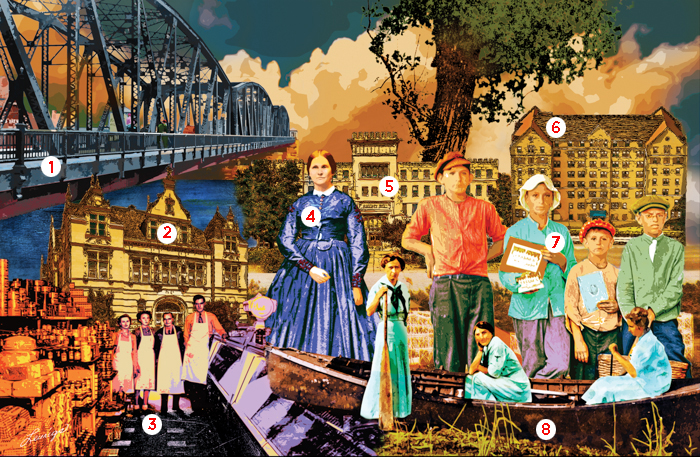Washington Street Gallery
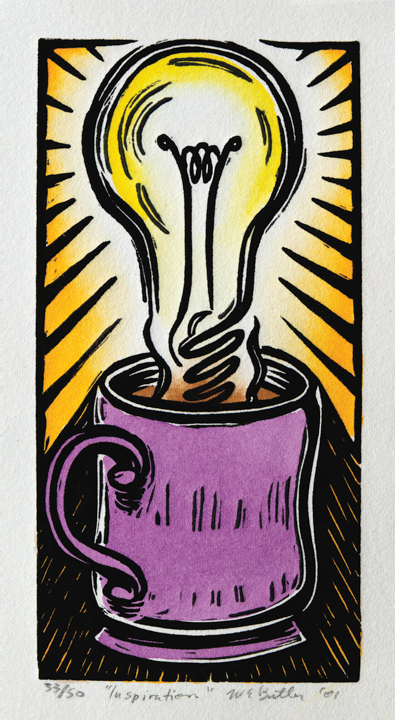
Inspiration
William Butler
One of a series of 14 hand-painted linoleum relief prints about the love of coffee, Inspiration portrays the power of caffeine to inspire creativity in us all. See more coffee art at his website and at his studio at the Contemporary Art Center.
Field Notes
by By Lori Reed
“I created the art from a photo that was taken by my friend, Ellen McDowell, who goes on walks every single day taking photos in Central Illinois. When I saw her photo of this field filled with blooming weeds, I purchased it to use in my art. I ran several filters on the image and picked three that gave the blooms different hues and textures. I hand cut prints of the images into quarter-inch strips and built my 12”x12” mixed media artwork from those strips, handmade papers (in green, pink and magenta) and some vintage 10-cent stamps that were the same color as the field.”
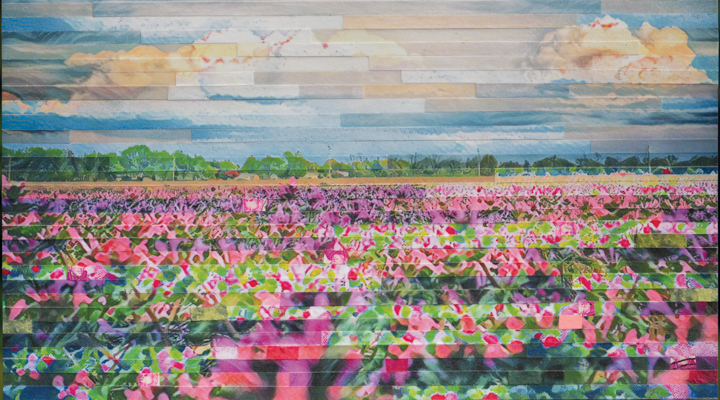
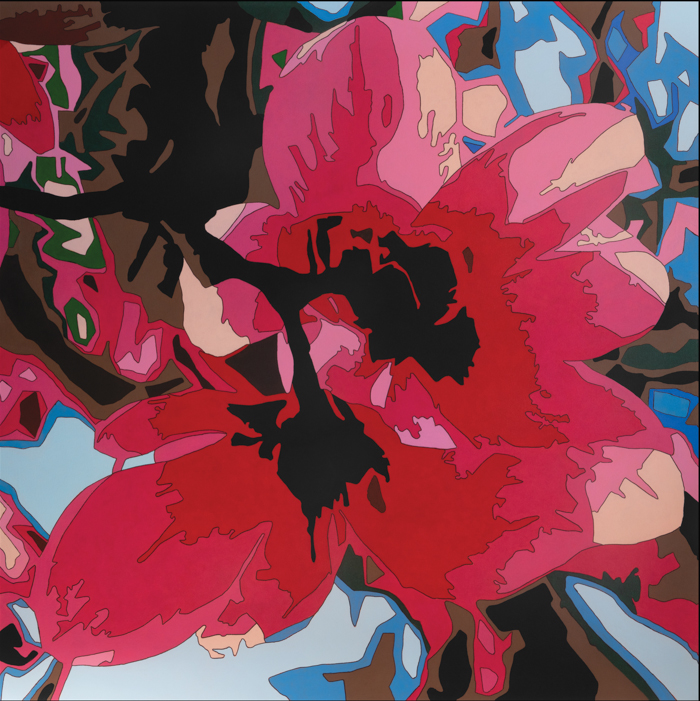
Big Mag 2.0
by Steph Van Doren
“I consider myself a social neo-abstractionist. I also consider myself an environmentalist. In the past I created work that commented on contemporary issues that plague nature and speculated possible solutions to the problem.
“In this series of work I don’t attempt to solve or mitigate environmental issues. My aim is to emphasize the forgotten beauty of nature and identify my place in it. I explore my own habitat and shoot photos of the landscape. Although I consider the photos a finished product, I love the feel of brush and paint on canvas. I select specific aspects from each image, deconstructing nature, to create a pseudo-realistic view of the Midwest. So, each painting is a reflection of that love, and nature is further reduced to the bare essentials of line, color, shape and light, independent of visual reference to the real.”
Gipps Brewery Ad
colored by Doug and Eileen Leunig
A vintage Gipps Amberlin beer ad hand colored by Doug and Eileen Leunig. Gipps Brewery was started in 1867 along Water Street on East Franklin Street. Gipps remained in operation until 1954. Gipps is a proud part of Peoria’s past and the Amberlin beer became its top seller. The original image is courtesy of the Peoria Public Library.

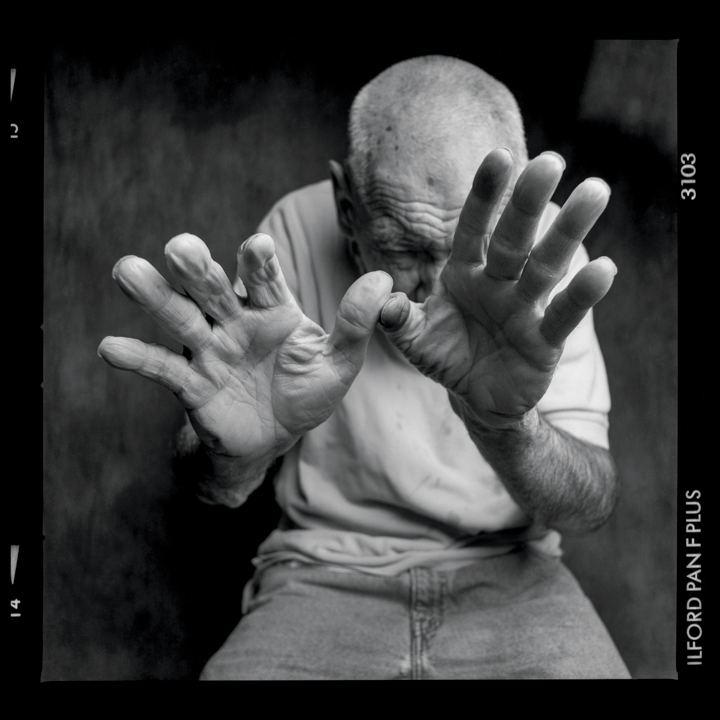
Leslie
by Keith Cotton
Photography embodies much more than its end result. Its process triggers a sensation of heightened awareness, where decisive moments simultaneously engage the conscious and subconscious, creatively merging technical details with an emotionally charged personal response. This firsthand experience is transmittable, it’s not only exclusive to the photographer, but to the viewer as well. Inertia of chance and technique delivers the outcome, and the literal and figurative artifact remains. Printed pictures offer a visual representation of circumstances, a portal attempting to convey the genuine truth of what it was like . . . “being there.”
My first interaction with Leslie McDonald happened during the summer of ’ 92, at my studio in Cobden, IL. Leslie was the kind of person that would require a second glance. A hunched over elderly man, slowly pacing the sidewalks of a small rural town, loosely gripping a sharpened sickle with a duct taped handle. Decades of smoking filterless Camels were apparent on his tar stained fingers, a barely audible raspy voice, missing teeth, countless wrinkles, and the occasional bandage added to his distinctive mystique. During my 17 years of shooting portraits in Southern Illinois, 12 of them involved documenting Leslie. We had an unspoken trust, an understanding that if he came to the studio to hang out, I’d more than likely photograph him. I’m uncertain how many times this friendly ritual happened. In retrospect, it wasn’t nearly enough.
Chopsticks
by Natalie Jackson
I came upon this little girl while at a jazz festival in Montreal. With music all around, she was in her own world playing her own sound. I was flooded with memories of my own music lessons many years ago. It just made me smile.
I asked her father if I could photograph her. She never even saw me.
I later processed the photo in the digital darkroom much like the rest of my jazz series. I digitally manipulated her with a whimsical feel.


Corvette
by Brian Jensen
Brian Jensen was a featured artist at the 2019 Peoria Art Guild Fine Art Fair and his work was selected for that year’s poster for the Guild.
Peoria's Colorful Past
by Doug & Eileen Leunig
Franklin Street Bridge, Peoria, IL, leading to the Larkin Store, “Comfort, Economy and Happiness,” / “Once a Tankful, Always Thankful,” located at 408 SW Washington Street, (and 401 Water Street) Peoria, IL. Larkin was a 65-store chain of general merchandise stores, including gasoline, sold in 1937 to Kroger Grocery & Baking Company. Peoria operations lasted until 1941. The Franklin Street Bridge photo was from the Glass Plate Collection taken by Dallas R. Sweney, who lived at 807 Spring Street, Peoria, IL. In the early 1920s Dallas was briefly a commercial photographer, the studio was located at 229 N. Adams, present day site of the Mark Twain Hotel, Dallas was a long-term employee at the Peoria Public Library. He was a World War I veteran, serving with the 33rd Division of the American Expeditionary Forces in France. The glass negatives were found during the salvage of a condemned Peoria home, decayed and much weather-beaten they were painstakingly digitally restored.
The Peoria Spalding Institute was a Catholic Boys School founded in 1899 by the Franciscan Brothers of Mountbellew, Ireland, at the behest of Bishop Spalding. The school took its namesake from the founder and first bishop of the Peoria Diocese, John Lancaster Spalding. The school served Peoria for 90 years, lasting until 1989, when the school partnered with Bergan High School to form Peoria Notre Dame High School. The former school is now the Spalding Pastoral Center housing the administrative and meeting offices for the Peoria Diocese and OSF Saint Francis Medical Center, also encompassing the Archbishop Fulton J. Sheen Museum and Diocesan Historical Museum.
“Alle in Der Familie”
Friedrich “Fred” Reichert immigrated to America from Germany in 1912 and opened his first grocery store in 1922 at 1007 W. Lincoln Ave. In 1932, he relocated to his new store at 1202 W. Starr St. to better serve the needs of the South Side community. It was from this store that his brother Christian, son-in-law Friedrich “Fred” Traub, and Perry Traub learned the butchering trade. Fred Reichert remained in this location until 1950 when he sold the business to Forrest “Frosty” Craighead.
The mural photo was taken in 1948 and includes the following individuals: Dorothy Reichert, Virginia Weber, Fred Reichert, & Forrest “Frosty” Craighead. Florence and Pauline Reichert, Fred Reichert’s other daughters, also worked in the store.
Christian and Rosa Traub Reichert opened their Reichert’s Market in 1931. In 1938, Reicherts purchased the former Proctor’s Market at 1724 North Sheridan Road and completely remodeled the store to include “state-of-the-art” refrigeration to ensure quality products to better serve the needs of the neighborhood. The store closed in 1973 after serving the Loucks-Sheridan neighborhood for forty-two years.
Son-in-law Friedrich “Fred” and Pauline Reichert Traub opened their market in 1934. Traub’s Market, located at 901 W. Armstrong originally sold just meat, however they expanded shortly thereafter adding groceries to serve the needs of the Columbia Terrace neighborhood. The market remained at that location until 1960 when Fred and Pauline Reichert Traub sold the business.
Perry Traub opened his market at 431 Rohmann Ave. in 1940. Perry sold meat and a variety of groceries to the West Peoria neighborhood until January 16, 1957 when a gas explosion took the lives of four persons, including Perry Traub.
Bradley University.
Bradley Hall, one of the University’s original buildings, is one of the main academic buildings on campus. It houses the main offices for the College of Liberal Arts and Sciences. It also houses faculty offices and lab space for the College of Education and Health Sciences
In 1875 a community of 25 Sisters departed for America, fleeing religious prosecution, known as the Kulturkampf “culture struggle”; a breakdown between the government of Prussia and the Roman Catholic Church, chiefly entered on the rights and authority over ecclesiastical appointments. The Sisters settled in Iowa City, setting up an orphanage and school. Chronically underfunded, on a Midwestern fundraising and canvassing tour, they made a stop in Peoria, given the large German-American community present. During their stay in Peoria, they met with Pastor of St. Joseph Church. Fr. Bernard Baak, who requested the Sisters help in establishing a hospital in Peoria, accepting the offer, six Sisters returned, renting a house on South Adams Street. A year later the Sisters purchased a home on the East Bluff from Lydia Moss Bradley. Upon arriving as the First Bishop of the Peoria Diocese Archbishop John Lancaster Spalding, toured the facilities, and upon seeing the difficult operating and funding conditions, Spalding encouraged the Sisters to form a separate congregation with the Diocese’s fulll backing and support.
OSF Saint Francis Medical Center is now the largest hospital in the Peoria metropolitan area and has expended to include the Children’s Hospital of Illinois, the OSF Saint Francis Heart Hospital, the Illinois Neurological Institute, and the OSF Saint Francis Medical Center College of Nursing.
Concession stand runners and helpers, circa 1916, servicing the Lake View Park baseball field. Lake View Park (1883-1921). Lake View Park was near the Illinois River, at the foot of Grant Street, Averyville-Peoria, Illinois. Lake View Park was the home of the Peoria Distillers, a Triple-I League team (Illinois-Indiana-Iowa League). The Peoria Distillers entered the league in 1905, winning three league championships; in 1911, 1916 and 1917. Baseball was suspended in 1918 on account of World War I, when the Distillers returned in 1919, they changed their name to the Peoria Tractors.
Canoe outing on the Illinois River from the photo album entitled “Glimpses of Peoria (1912-1915) As Seen by Mary Camp Scovel.” Mary Camp Scovel (middle) was an art educator, painter, and potter. During Mary’s stay in Peoria, she was the instructor of the Normal Art Course at Bradley Polytechnic Institute. Mary Camp Scovel was born in Bloomington, IL, on Feb. 19, 1869. Scovel headed the teacher training program at the Art Institute of Chicago for many years. Upon retirement in 1933, she moved to California and settled in Carmel; she died there on Oct. 18, 1941.
